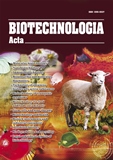ISSN 2410-7751 (Print)
ISSN 2410-776X (Online)

Biotechnologia Acta Т. 17, No. 2 , 2024
P. 14-17, Bibliography 5, Engl.
UDC::577.
DOI: https://doi.org/10.15407/biotech17.02.014
THE RESTORATION OF HYBRIDOMA CELLS LINES AFTER UNSUITABLE STORAGE
K.B. Baidakova 1, 2, O.P. Kostuchenko1, K.P. Klymenko1, O.O. Gryshchuk1, D.S. Korolova1
1 Palladin Institute of Biochemistry of the National Academy of Sciences of Ukraine, Kyiv
2 Educational and Scientific Center “Institute of Biology and Medicine” of Taras Shevchenko National University of Kyiv, Ukraine
The ongoing war in Ukraine has disrupted the infrastructure of cryopreservation, compromising the viability of hybridoma cell lines that are critical to therapeutic antibody production. This study focuses on hybridoma cells that produce antibodies targeting protein C. They were damaged by wrong preservation conditions: in a freezer at -80 °C.
The aim of the study was to identify optimal culture conditions for restoring the functionality and antibody production capacity of these compromised hybridoma cells.
Materials and methods. The cryopreserved hybridoma clone, producing the IV-6A antibody, was used. After thawing, the cells were cultured in RPMI medium supplemented with 10% of three different commercially available Fetal Bovine Serum (FBS) variants: F7524 and F2442 (Sigma, USA) and One Shot format A5256701 (Gibco, USA). Cell vitality was monitored through daily observations with a light microscope. Quality assessment of antibody production was conducted through ELISA analysis. The binding capacity of the purified antibody was compared against a reference.
Results. Hybridoma cells cultured in RPMI medium with F7524 or F2442 FBS exhibited a significant decrease in viability by day 4. Conversely, cells cultured with A5256701 FBS displayed high viability and an exponential growth pattern. ELISA confirmed that these cells retained the ability to produce the monoclonal antibody IV-6A. However, the purified antibody from the restored cell line showed a slightly less intensive binding capacity compared to the reference antibody.
Conclusions. Despite the lasting improper storage conditions, the hybridoma cells were successfully restored retaining their ability to produce monoclonal antibodies specific to protein C.
Key words: hybridoma cells, monoclonal antibody, protein C, ELISA.
REFERENCES
- Ishizaki T., Takeuchi Y., Ishibashi K., Gotoh N., Hirata E., Kuroda, K. Cryopreservation of tissues by slow-freezing using an emerging zwitterionic cryoprotectant. Scientific reports. 2023, 13(1): 37. https://doi.org/10.1038/s41598-022-23913-3
- Gustafsson B. Cryopreservation of hybridomas. Methods in molecular biology (Clifton, N.J.). 1990, 5: 619–621. https://doi.org/10.1385/0-89603-150-0:619
- Rebuilding Ukrainian science can't wait - here's how to start. Nature. 2023, 614(7949): 593–594. https://doi.org/10.1038/d41586-023-00505-3
- Ladokhin A. S. Ukrainian science in the context of its anticolonial struggle. BBA advances. 2023, 3: 100093. https://doi.org/10.1016/j.bbadva.2023.100093
- Hryshchuk V.I., Zhernosekov D.D., Bereznytskyi G.K. Comparative characteristics of C protein purification methods. Visnyk of Taras Shevchenko Kyiv National University.2010, 13: 39‒43.
© Palladin Institute of Biochemistry of National Academy of Sciences of Ukraine, 2024

